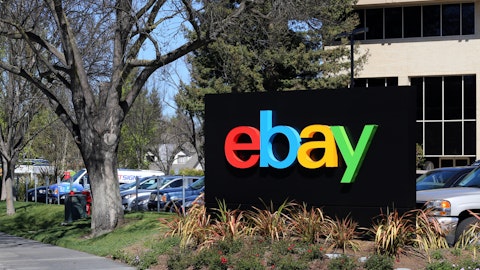John Lai: Yes. I think you’re spot on, John. And so directionally, as we look to kind of compress that delta between our Platinum and our Titanium, to make it more within reach and easier for folks to upgrade, that’s going to be part of our overall design. Again, we want to be very clear in how we transition existing members into a new price point. And there are certain rules and things that we need to do from a communication standpoint, so that they are given ample notice. So we’re working through the mechanics of that as we speak, but you nailed it. At the end of the day, as we’re settling in on what we believe the Titanium price to be, anything we can do to make that more attractive and more within reach, that would help us achieve our goals. But we are balancing to your comment, this mutual objectives behind increasing the number of members in each of our premium packages, while maximizing profitability.
John Heinbockel: All right. And then I guess a second topic, right, the idea of buy versus build, right, and how close the cost of buy has to be to build, to make that more attractive to you. Are we – it seems like we’re getting closer. You’re thought on that, and are we within reach where the economics are more compelling or competitive on the buy side?
John Lai: Yes, it’s – we’re getting there. So prices on M&A are definitely coming down. The cost of build is going up, and so there will be a point where both become equally attractive. I think it’s important to note that as a company we’re agnostic, at the end of the day between greenfield and acquisitions, and we will deploy capital where we can generate the highest return. There’s pros and cons to both sides of that equation. The greenfields, we can – I’m not going to say, control our own destiny, but really set up the stores to our specifications and design in the way we want. But M&A is also an attractive path for us, particularly as we look to move into new markets and accelerate that path into a new market. So that, coupled with bolt-ons, which will always be part of the equation. So we’re not quite there yet in terms of that equilibrium point, but it’s moving in that direction.
John Heinbockel: Okay, thank you.
Operator:
Q – Michael Lasser:
Michael Lasser: Good evening. Thanks a lot for taking my question. John, at the outset of your remarks, you mentioned an increasingly competitive environment, while Mister Car Wash has operated in a competitive environment for a long time. Are the dynamics changing where it’s just more difficult to attract new members to your club, given that the 6,000 net additions is one of the smallest increases that you’ve reported since you’ve been a publicly traded company?
John Lai: Well, there’s kind of three questions inside that question, Michael, which you’re famous for. So to answer the middle part of your question, we haven’t seen a slowdown in member growth through our greenfield locations. Q3 though, was relatively flat from a UWC net member growth standpoint and that was somewhat intentional. We prioritized converting existing members into our Titanium program in Q3 as we’re launching and rolling this out, and it’s really hard when you get down to the store level to have multiple objectives happening simultaneously. So we err on the side of, let’s take existing members and introduce them to Titanium, rather than focusing what had been our primary focus, which is on converting retail customers into membership.
And so that will be – we’re in execution mode on Titanium right now, and that’s going to be our primary focus over the next several quarters. But equally, both sides of that are equally important to us over time. And so with respect to your question about competition, we have not felt any meaningful impact to our growth trajectory due to the current competitive environment.
Jed Gold: Hey Michael, one other point I think is worth highlighting. When you look at the seasonality of UWC growth, its 65% to 70% of our UWC sign-ups have typically been in the first half of the year. And when you look at the more recent years, that’s been even more pronounced, but that’s – to John’s point, that’s where we’re really optimistic and excited about Titanium, is because we now have these 2.1 million existing UWC members that are at bets [ph] and driving the top line through trading them into Titanium.
Michael Lasser: And Jed, in your comments you had noted that core churn is stable. Does that mean you’re – I think you alluded to experiencing some higher churn, which would be consistent with John’s comments around focusing on the conversions rather than the new customers. Can you explain and frame how we should think about churn into 2024? And then how does that impact overall membership growth in the next year, especially on the heels of the retail business being softer for the last several quarters, and that being a source of new member growth?
Jed Gold: Yes. So when we talk about core churn, previous calls we’ve shared that we’ve been testing various marketing initiatives, promotions. And what we have found that really works is introductory and trial price offers, where we’re trying to get new customers to try Titanium and really accelerate that trial and drive mix to those more premium packages. What happens is, it comes at the price of slightly higher churn, and we talked about it in the prepared remarks in Q2, also talked about in Q3, where when we roll to the regular pricing, we see a slight uptick in churn. For Q3, it was about two-tenths of an uptick in our churn, with promotional UWC members rolling back to regular. So it’s not outsized or anything to be overly concerned about at this point, but something that we’re keeping a close eye on and making sure that the end objective though is to drive that mix and get as many members in our premium package as we can.
John Lai: Jed, if I could just add too. I think we’ve been very responsible and smart, quite frankly, and not getting too aggressive in some of those introductory trial offers. We’ve seen some silly stuff out there where folks are, I call it giving away the farm with $0.99 offers, $0.001 offers for the first month. And that could be a slippery slope, and there’s an old adage, the way in which you acquire a member is the way in which you need to keep a member. But if you’re leaning really heavily in on the price side of the equation, which we haven’t, that is going to have – it’s going to come at a cost, and that cost is a higher churn.
Jed Gold: One other point, Michael, I think is really important for folks to hear and kind of the proverbial yellow canary is UWC usage. Obviously, a customer is more inclined to cancel out of a subscription that they are not using. When we look at usage of UWC during the quarter, we did not see any downtick there. Customers – our UWC customers are washing as much as they have in past quarters.
Michael Lasser: Got you. Thank you so much. Good luck!
Operator: Thank you. And the next question comes from Randy Konik with Jefferies.
Randy Konik: Yes. Good afternoon. Thanks a lot. I guess a question for you, Jed. You talked about the, back to the retail side of the business. I think you said double-digit negative comps in the first quarter, down high single in the second quarter and the third quarter was a little bit better. Based on what you’re seeing across the different regions, do you think that based on the business and as it stands today in retail, as we kind of get towards the first quarter and go up against that negative double-digit type of compare, is that – can we kind of think through that the retail side of the ledger should start to kind of get towards flattish or slightly positive as we go up against that comparison based on what you are seeing right now? I just wanted to just get a feel for that trend line.



